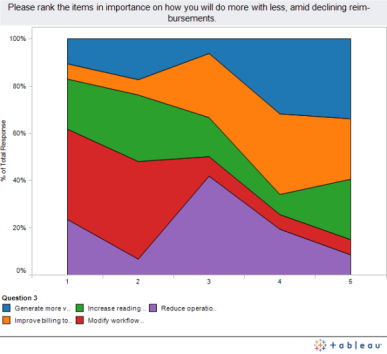How Radiologists Are Doing More with Less
How do radiologists do more with less amid declining reimbursements? Check out Part 2 of the results of our business analytics survey.
In Part 2 in a series analyzing the results of a recent business analytics survey, I’ll review what respondents would do with better analytics. Part 1 covered satisfaction with reporting practices.
(Click on the chart to explore interactive data)
Please rank the items in importance on how you will do more with less, amid declining reimbursements.
• Modify workflow efficiencies to maximize capacity -2.063
• Increase reading radiologists’ productivity -2.854
• Reduce Operation Costs -2.875
• Generate more volume through marketing-3.583
• Improve billing to maximize collections- 3.646
The visualizations
The clear winner is modifying workflow to maximize capacity, with an average rank of 2.063. You can see in the chart how often workflow capacity was ranked as ranked No. 1 or No. 2. As a largely fixed cost business, being able to push more volume through the existing infrastructure would mean improvement directly to the bottom line.
Bundled together in Nos. 2 and 3, but with very different trends, are increasing radiologist productivity and reducing operational costs at 2.854 and 2.875, respectively.
Improving reading radiologist productivity is interesting, because it is ranked highly as one and two (in green) but then has a spike in those that rank it No. 5. Those who ranked it high see the value in reading more cases. This offsets the declining reimbursements or can raise income. But those ranking it as five have probably implemented productivity enhancing processes and don’t see additional productivity that can be squeezed. Others are probably ranking it high to combat the sweatshop attitude, seeing that there are other ways to improve then just chaining a radiologist to the desk.
Reducing operational costs, while close in the average ranking to increasing productivity, has a very different trend. It derives most of its ranking from a strong No. 1 and a very high No. 3 spot and trailing off in four and five. While many may be divided among what should be the top two items, reducing operational costs is very strong at No. 3.
Coming in at a close finish for fourth and fifth places at 3.583 and 3.646 is generating more volume through marketing and improving billing to maximize collections. Notice how the things that are perceived to be more in control within your organization are ranked higher and the things that are influenced by external factors, such as referring physician and payers are ranked lower? We value the things that we feel we can control.
Generating more volume through marketing is s relatively flat response. It loses out in third place, because reducing operational costs does so well. But it has a good showing even in first and second place. I think this is because focusing on marketing has a lot of implications. Getting more volume through marketing is only beneficial if you have the capacity in facilities and in reading radiologist. Those that have the capacity will tend to rank it high, while others see so much more value in other areas.
Coming in at last place is improving billing to maximize collections. This ranking is due primarily to its horrible performance in first and second place; very few people ranked it so high. I attribute this primarily to the gains that have been made in billing in recent years and to the sense that problems with reimbursement lay in large part with struggles with payers.
In the third and final part, I will cover why respondents do not invest in business analytics.
David Fuhriman, MBA, CPA, is CEO of Bern Medical.
The Reading Room Podcast: Current Perspectives on the Updated Appropriate Use Criteria for Brain PET
March 18th 2025In a new podcast, Satoshi Minoshima, M.D., Ph.D., and James Williams, Ph.D., share their insights on the recently updated appropriate use criteria for amyloid PET and tau PET in patients with mild cognitive impairment.
Meta-Analysis Shows Merits of AI with CTA Detection of Coronary Artery Stenosis and Calcified Plaque
April 16th 2025Artificial intelligence demonstrated higher AUC, sensitivity, and specificity than radiologists for detecting coronary artery stenosis > 50 percent on computed tomography angiography (CTA), according to a new 17-study meta-analysis.

